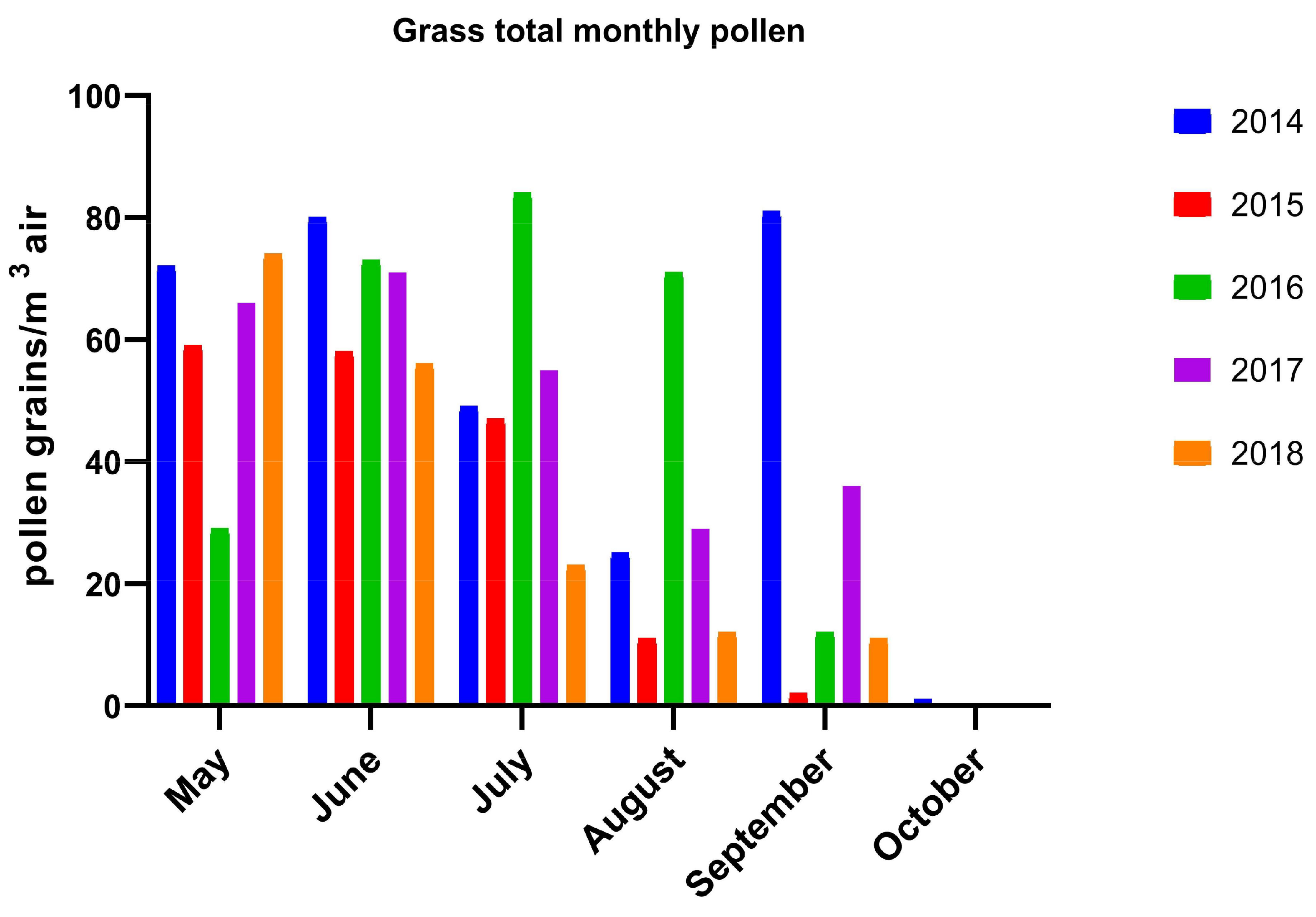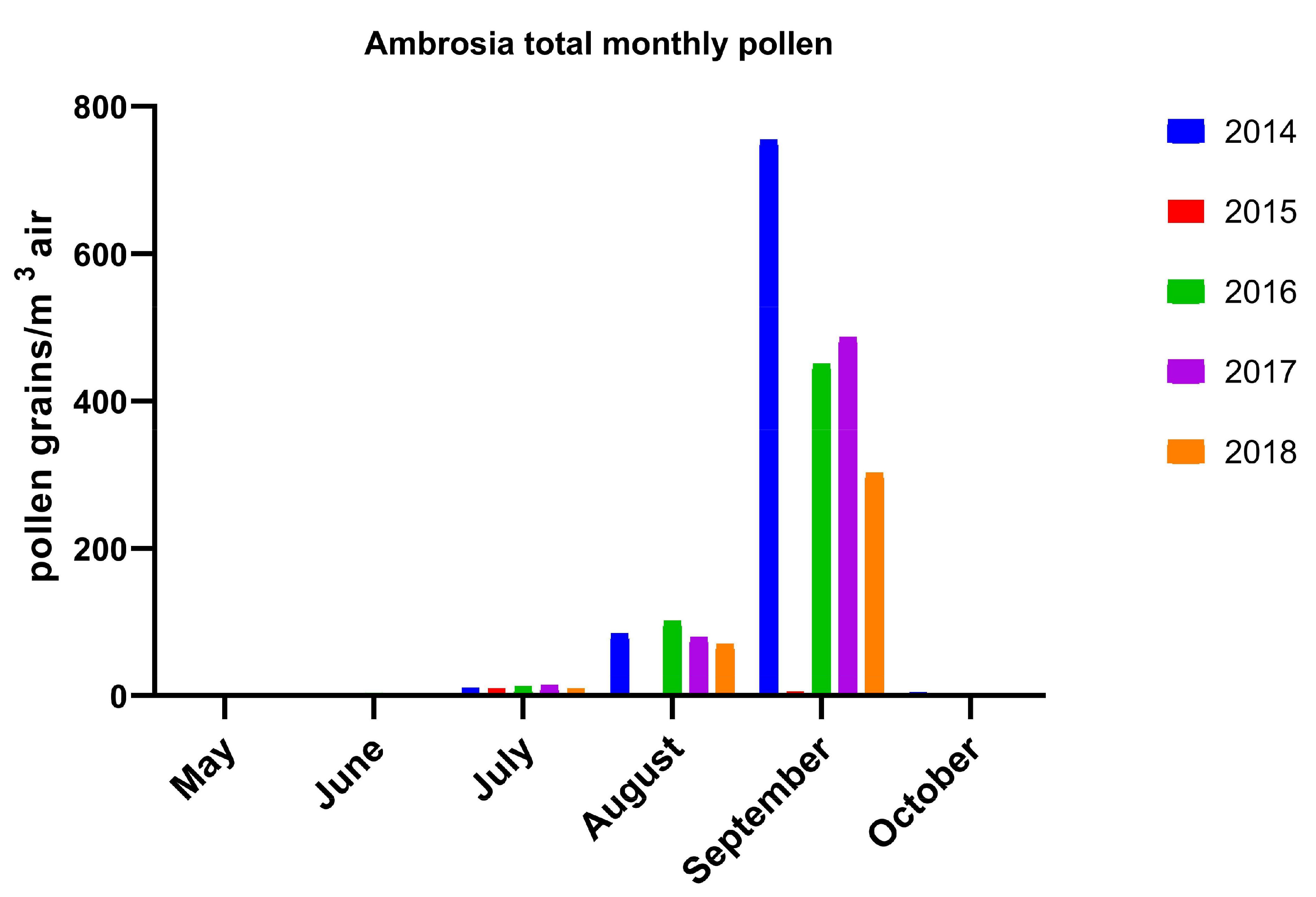Five-Year Data on Pollen Monitoring, Distribution and Health Impact of Allergenic Plants in Bucharest and the Southeastern Region of Romania
Abstract
:1. Introduction
2. Materials and Methods
2.1. Pollen Monitoring in the City of Bucharest
2.2. Distribution of Allergenic Plants in Bucharest
2.3. Evaluation of Ambrosia Pollen Induced Allergies
3. Results
3.1. Pollen Monitoring Data in Bucharest between 2014 and 2018
3.2. Preliminary Data on Distribution of Allergenic Plants in Bucharest
3.3. Preliminary Data on Health Impact of Ambrosia in Bucharest
4. Discussion
5. Conclusions
Author Contributions
Funding
Conflicts of Interest
References
- Tanno, L.K.; Calderon, M.; Linzer, J.F.; Chalmers, R.J.; Demoly, P.; Joint Allergy Academies. Collaboration between specialties for respiratory allergies in the International Classification of Diseases (ICD)-11. Respir. Res. 2017, 18, 34. [Google Scholar] [CrossRef] [PubMed]
- Maio, S.; Baldacci, S.; Carrozzi, L.; Pistelli, F.; Angino, A.; Simoni, M.; Sarno, G.; Cerrai, S.; Martini, F.; Fresta, M.; et al. Respiratory symptoms/diseases prevalence is still increasing: A 25-yr population study. Respir. Med. 2016, 110, 58–65. [Google Scholar] [CrossRef] [PubMed]
- Cecchi, L.; Bonini, S.; Nunes, C.; Behrendt, H.; Liccardi, G.; Popov, T.; Van Cauwenberge, P.; D’amato, G.; Annesi-Maesano, I. Allergenic pollen and pollen allergy in Europe. Allergy 2007, 62, 976–990. [Google Scholar]
- Sikoparija, B.; Skøjth, C.A.; Celenk, S.; Testoni, C.; Abramidze, T.; Alm Kübler, K.; Belmonte, J.; Berger, U.; Bonini, M.; Charalampopoulos, A.; et al. Spatial and temporal variations in airborne Ambrosia pollen in Europe. Aerobiologia 2017, 33, 181–189. [Google Scholar] [CrossRef] [PubMed]
- Blackley, C. Experimental Researches on the Causes and Nature of Catarrhus Aestivus (Hay Fever, Hay Asthma); Baillière, Tindall & Cox: London, UK, 1873. [Google Scholar]
- Hyde, H.A. Volumetric counts of pollen grains at Cardiff, 1954–1957. J. Allergy 1959, 30, 219–234. [Google Scholar] [CrossRef]
- Ianovici, N. The first pollen monitoring centre in Timisoara (Romania). Allergen flora in urban areas (1999–2010). In Proceedings of the Conferinta de incheiere a proiectului „Biodiversitatea si protectia naturii”—O abordare responsabila a problemelor de mediu a doua orase infratite—BioTowns, Timisoara, Romania, 23 February 2012. [Google Scholar]
- Leru, P.M. Activities of Romanian group in the COST Project SMARTER FA-1203 during 2013–2016. In Proceedings of the COST FA1203—SMARTER Final Conference, Vianden, Luxembourg, 11–13 September 2016. [Google Scholar]
- Galán, C.; Smith, M.; Thibaudon, M.; Frenguelli, G.; Oteros, J.; Gehring, R.; Berger, U.; Clot, B.; Brandao, R.; EAS QC Working Group. Pollen monitoring: Minimum requirements and reproducibility of analysis. Aerobiologia 2014, 30, 385–395. [Google Scholar] [CrossRef]
- Leru, P.M.; Eftimie, A.M.; Thibaudon, M. First allergenic pollen monitoring in Bucharest and results of three years collaboration with European aerobiology specialists. Rom. J. Int. Med. 2018, 56, 27–33. [Google Scholar] [CrossRef] [PubMed]
- Buters, J.; Prank, M.; Sofiev, M.; Pusch, G.; Albertini, R.; Annesi-Maesano, I.; Antunes, C.; Behrendt, H.; Berger, U.; Brandao, R.; et al. Variation of the group 5 grass pollen allergen content of airborne pollen in relation to geographic location and time in season. J. Allergy Clin. Immunol. 2015, 136, 87–95.e6. [Google Scholar] [CrossRef] [PubMed]
- Ianovici, N.; Panaitescu Bunu, C.; Brudiu, I. Analysis of airborne allergenic pollen spectrum for 2009 in Timișoara. Aerobiologia 2013, 29, 95–111. [Google Scholar] [CrossRef]
- Leru, P.M.; Matei, D.; Ianovici, N. Health impact of Ambrosia artemisiifolia reflected by allergists practice in Romania. A questionnaire-based survey. Ann. West Univ. Timis. Biol. 2015, 18, 43–54. [Google Scholar]
- Buters, J.; Antunes, C.; Galveias, A.; Bergmann, K.C.; Thibaudon, M.; Galán, C.; Schmidt-Weber, C.; Oteros, J. Pollen and spore monitoring in the world. Clin. Transl. Allergy 2018, 8, 9. [Google Scholar] [CrossRef] [PubMed]
- Traidl-Hofmann, C.; Kasche, A.; Menzel, A.; Jakob, T.; Thiel, M.; Ring, J.; Behrendt, H. Impact of pollen on human health: More than allergen carriers? Int. Arch. Allergy Immunol. 2003, 131, 1–13. [Google Scholar] [CrossRef] [PubMed]
- Thibaudon, M.; Faucherand, L.; Oliver, G. Urban vegetation and allergy risk. In Proceedings of the EAACI Annual Congress, Milan, Italy, 22–26 June 2013. [Google Scholar]


| Year | Pollen Species | March | April | May | June | July | Pollen Species | March | April | May | June | July |
|---|---|---|---|---|---|---|---|---|---|---|---|---|
| 2014 | Mulberry (Moraceae) | 1247 | 51 | 5 | Poplar (Salicaceae) | 401 | 2 | 1 | ||||
| 2015 | 456 | 18 | 198 | 49 | ||||||||
| 2016 | 41 | 1 | 12 | 21 | 19 | 28 | 1 | |||||
| 2017 | 466 | 40 | 3 | 34 | 148 | 2 | ||||||
| 2018 | 135 | 39 | 2 | 5 | 79 | 5 | ||||||
| 2014 | Cypress (Cupressaceae) | 115 | 7 | 2 | 2 | 1 | Elm (Ulmaceae) | 120 | 7 | |||
| 2015 | 272 | 10 | 10 | 1 | 104 | 17 | ||||||
| 2016 | 35 | 29 | 40 | 7 | 11 | 30 | 10 | |||||
| 2017 | 200 | 40 | 15 | 6 | 4 | 13 | 2 | |||||
| 2018 | 22 | 17 | 2 | 3 | 26 | |||||||
| 2014 | Alder (Betulaceae) | 143 | 26 | Birch (Betulaceae) | 86 | 12 | 2 | |||||
| 2015 | 15 | 4 | 4 | 8 | 15 | 3 | 2 | |||||
| 2016 | 31 | 1 | 3 | 2 | 47 | 14 | 4 | 3 | 3 | |||
| 2017 | 51 | 169 | 2 | 39 | 4 | |||||||
| 2018 | 41 | 12 | ||||||||||
| 2014 | Linden (Tilia) | 5 | 1 | 30 | 7 | Platanus (Platanaceae) | 28 | 2 | 1 | |||
| 2015 | 1 | 2 | 7 | 22 | 5 | 29 | ||||||
| 2016 | 6 | 22 | 17 | |||||||||
| 2017 | 5 | 24 | 3 | 85 | 4 | |||||||
| 2018 | 14 | 6 | ||||||||||
| 2014 | Pinus (Pinaceae) | 28 | 4 | 1 | Quercus (Fagaceae) | 100 | 4 | 1 | ||||
| 2015 | 2 | 30 | 9 | 1 | 5 | 6 | 4 | 4 | ||||
| 2016 | 1 | 16 | 3 | 2 | 2 | 1 | 4 | 2 | ||||
| 2017 | 12 | 41 | 8 | 2 | 35 | 50 | 12 | 2 | 3 | |||
| 2018 | 1 | 25 | 2 | 8 | 56 | 12 | ||||||
| 2014 | Fraxinus (Oleaceae) | 70 | 30 | 10 | 9 | 1 | Juglans (Juglandaceae) | 15 | 16 | |||
| 2015 | 80 | 52 | 44 | 2 | 6 | 4 | ||||||
| 2016 | 17 | 9 | 16 | 7 | 1 | 5 | ||||||
| 2017 | 30 | 55 | 23 | 4 | 20 | 2 | ||||||
| 2018 | 54 | 20 |
| Plant Family | Species | Spreading | Flowering Period |
|---|---|---|---|
| Grasses and Weeds | Poaceae (Dactylis glomerata, Festuca rubra, Poa pratensis, Phleum pratense, Lolium perenae) | Common | Spring–summer |
| Asteraceae (Ambrosia artemisiifolia and trifida, Artemisia vulgaris and absinthium) | Very common | Summer–autumn | |
| Trees | Tiliaceae | Very common | May–June |
| Juglandaceae | Common | April–May | |
| Fagaceae | Common | April–May | |
| Platanaceae | Very common | April–May | |
| Salicaceae | Common | Early spring | |
| Oleacea | Common | April–May | |
| Aceraceae | Common | April–May | |
| Pinaceae | Common | Early spring | |
| Ulmaceae | Common | Early spring |
© 2019 by the authors. Licensee MDPI, Basel, Switzerland. This article is an open access article distributed under the terms and conditions of the Creative Commons Attribution (CC BY) license (http://creativecommons.org/licenses/by/4.0/).
Share and Cite
Leru, P.M.; Eftimie, A.-M.; Anton, V.F.; Thibaudon, M. Five-Year Data on Pollen Monitoring, Distribution and Health Impact of Allergenic Plants in Bucharest and the Southeastern Region of Romania. Medicina 2019, 55, 140. https://doi.org/10.3390/medicina55050140
Leru PM, Eftimie A-M, Anton VF, Thibaudon M. Five-Year Data on Pollen Monitoring, Distribution and Health Impact of Allergenic Plants in Bucharest and the Southeastern Region of Romania. Medicina. 2019; 55(5):140. https://doi.org/10.3390/medicina55050140
Chicago/Turabian StyleLeru, Polliana Mihaela, Ana-Maria Eftimie, Vlad Florin Anton, and Michel Thibaudon. 2019. "Five-Year Data on Pollen Monitoring, Distribution and Health Impact of Allergenic Plants in Bucharest and the Southeastern Region of Romania" Medicina 55, no. 5: 140. https://doi.org/10.3390/medicina55050140
APA StyleLeru, P. M., Eftimie, A.-M., Anton, V. F., & Thibaudon, M. (2019). Five-Year Data on Pollen Monitoring, Distribution and Health Impact of Allergenic Plants in Bucharest and the Southeastern Region of Romania. Medicina, 55(5), 140. https://doi.org/10.3390/medicina55050140






